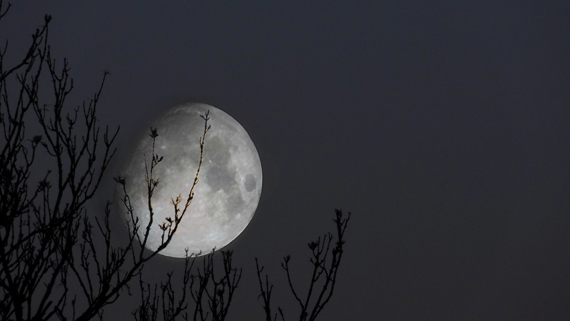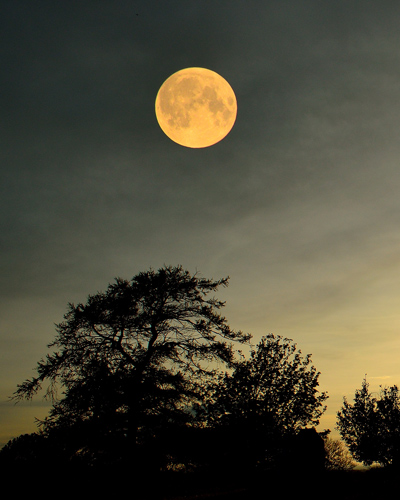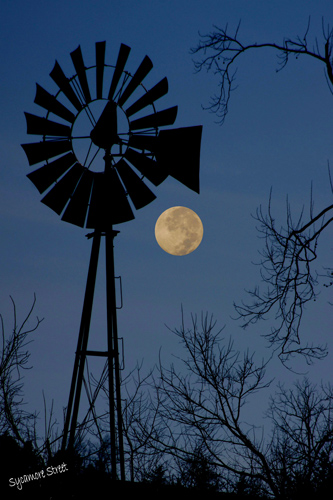If care is not taken when photographing the moon, it is likely that you will get either an overly dark photo, a moon that looks like the sun, a very small moon, or all of the above. I would like to offer some tips on a different strategy for making compelling moon photographs.

“Moon” captured by PictureSocial member Navid Qureshi
So let’s first discuss why it is so difficult to photograph the moon. There are two main issues:
- the brightness of the moon
- the size of the moon
Almost everyone has experienced a “moon-lit night”. This is when a full moon, or nearly full moon, lights up a dark night. You see everything around you fairly well, which is evidence that the small amount of sunlight that the moon reflects is actually quite bright.
Why is this a problem for moon photography? When the moon is so bright and everything itself is much darker, it is impossible to make a photo where both the moon and the subject are clearly visible. Either the moon is very bright and washed out (and everything else is properly exposed), or the moon’s details are well-defined, but everything else is black or very dark. We’ll get to possible solutions in a little bit.
The other problem with moon photography is that the moon is actually quite small in the sky. Using a normal lens will cause the moon to appear very small in the resulting photo. This will not usually create a compelling image, even if the frame is properly exposed. Of course, you can use a zoom lens and take a photo of the moon, but that is usually pretty boring.
Tips for Photographing the Moon
So what is a photographer to do? My suggestions are as follows:
- Plan on photographing a full moon at or near moonrise or moonset, when the moon is very near the horizon.
- Look for interesting subjects that are large (e.g., buildings or trees), are in a flat region, and are visible from a distance of a few hundred feet to a few hundred yards.

“The Super Moon” captured by PictureSocial member Fergal Gleeson
- Research the direction/angle (the azimuth) where the moon will rise or set in a given month, and select a location where the moon will be easily be visible and adjacent to the subject from a distance.
OK, you may not be able to easily visualize these ideas, but let me explain what I’m trying to accomplish here. I want you to photograph the full moon near the horizon, from a distance, and with an interesting subject in the frame. The reason I want you to photograph the full moon near the horizon is because the light it is emitting nearly matches the ambient light of the rest of the world at that time. That’s because the sun is directly behind you and it is illuminating both the moon and your subject equally.

“Windmill Moon” captured by PictureSocial member David Farmer
This concept of even lighting only works with the full moon, because during other phases of the moon the moon is either too high in the sky or below the horizon when the sun is behind you.
Now, simply photographing the moon near the horizon does not alone make for an interesting image. So think about making the moon LARGE in the frame, and in combination with an interesting subject. This is the hard part. You obviously will be using a zoom lens for this, so you will be shooting BOTH the moon and the subject from a distance. They need to be very near each other in the frame. This is where a lot of planning is needed. You need a large, unobstructed, flat area for this (i.e. no hills, trees, buildings, etc) so that the rising or setting moon is visible.
There are websites for researching the direction and time of moonrises and moonsets throughout the year. There are only about 12 full moons per year (sometimes 13), so you may end up getting very few good opportunities to make the shots you are planning. And don’t forget about mother nature–a single cloud can ruin all of your plans.
I hope you can make use of these tips in your moon photography.
About the Author:
This article was written by Matt Shrier (shadesofgreenphoto.com), a photographer based in Bucks County Pennsylvania.
Go to full article: Shoot for the Moon: Tips on Photographing the Moon
What are your thoughts on this article? Join the discussion on Facebook
PictureCorrect subscribers can also learn more today with our #1 bestseller: The Photography Tutorial eBook
The post Shoot for the Moon: Tips on Photographing the Moon appeared first on PictureCorrect.
from PictureCorrect https://ift.tt/2w3tQgy
via IFTTT






0 kommenttia:
Lähetä kommentti